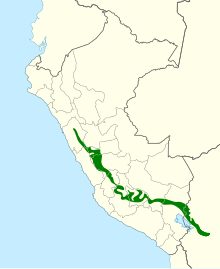Brown glossy tail
| Brown glossy tail | ||||||||||||
|---|---|---|---|---|---|---|---|---|---|---|---|---|

Shiny brown tail illustrated by John Gould and William Matthew Hart |
||||||||||||
| Systematics | ||||||||||||
|
||||||||||||
| Scientific name | ||||||||||||
| Chalcostigma olivaceum | ||||||||||||
| ( Lawrence , 1864) |
The brown glossy tail ( Chalcostigma olivaceum ) or sometimes olive pearly tail is a species of bird from the hummingbird family (Trochilidae) that occurs in Peru and Bolivia . The IUCN assesses the population as Least Concern .
features
The brown shiny tail reaches a body length of about 14 to 15 cm, with a weight of 8 to 9 g. The male has a short straight black beak. The body is uniformly dark olive green. The narrow throat patch is emerald green with a color extension downwards through yellow, pink to blue-gray or purple with a blue-violet tip. This gives him the face of a beard. The tail is forked and dull olive green. Females are similar to males but have an incomplete throat patch and reduced beard. The outer control springs have a pale tip. Immature juveniles resemble the females.
Behavior and nutrition
The brown glossy tail gets its nectar from drooping red plants, probably from the genus Castilleja on marshy slopes. It feeds a lot on insects. It picks them from the ground while it hops over dense grass and cushioned plants. Even in the thick hair of soft cacti it is always looking for insects. Occasionally you can see it sitting on the ground, shooting upward with an arrow and catching flying insects. Males defend their forage territory . The foraging takes place in the lower to middle strata .
Reproduction
Brown shiny tails with enlarged gonads were analyzed in January . Young animals were observed from February to April in central Peru and in May around La Paz. When it breeds, it seems to be attracted to Polylepis . The clutch consists of two eggs. The hatching is done by the female.
Vocalizations
The singing has not yet been scientifically described. It could be that there are hardly any noises.
migration
Little research has been done into the migration behavior of the brown gloss tail. It is assumed that it is a stationary bird or migrates as a seasonal line bird .
distribution and habitat
The brown glossy tail prefers typical Puna grasslands and soft plant communities that are sometimes connected with bushes. It can also be seen on the edges of dense Polylepis and Gynoxys forests. It moves at altitudes between 3600 and 4600 meters.
Subspecies
There are two known subspecies:
- Chalcostigma olivaceum pallens Carriker , 1935 is widespread in central Peru. This subspecies is a bit smaller and looks a bit lighter in appearance.
- Chalcostigma olivaceum olivaceum ( Lawrence , 1864) occurs in the southeast of Peru to central Bolivia.
Etymology and history of research
The first description of the Brown Glanzschwänzchens was made in 1864 by George Newbold Lawrence under the scientific name Ramphomicron olivaceus . The type specimen came from La Paz . In 1854 Heinrich Gottlieb Ludwig Reichenbach introduced the new genus Chalcostigma . This name is derived from the Greek words "chalkos χαλκός " for "bronze, bronze-colored" and "stigma στίγμα " for "feature, marking". The species name olivaceum is of Latin origin and is derived from "olivaceus" for "olive green" or "oliva" for "olive-colored". "Pallens" is derived from "pallentis, pallere" for "to be pale pale".
literature
- Martin Heindl, Peter Boesman in: Josep del Hoyo , Andrew Elliott, Jordi Sargatal , David Andrew Christie, Eduardo de Juana: Olivaceous Thornbill (Chalcostigma olivaceum) In: Handbook of the Birds of the World Alive . Lynx Edicions, Barcelona.
- James A. Jobling: Helm Dictionary of Scientific Bird Names . Christopher Helm, London 2010, ISBN 978-1-4081-2501-4 .
- George Newbold Lawrence: Descriptions of New Species of Birds of the Families Tanagridae, Cuculidae, and Trochilidae, with a Note on Panterpe Insignis . In: Annals of the Lyceum of Natural History of New York . tape 8 , 1867, p. 41-46 ( biodiversitylibrary.org ).
- Melbourne Armstrong Carriker, Jr: Descriptions of New Birds from Peru and Ecuador with critical Notes on other Little-known Species . In: Proceedings of the Academy of Natural Sciences of Philadelphia . tape 87 , 1935, pp. 343-359 ( books.google.de ).
- Heinrich Gottlieb Ludwig Reichenbach: Enumeration of the hummingbirds or trochilids in their true natural relationship, including the key to their systematics . In: Journal of Ornithology . 2 (separate issue), 1854, p. 1-24 ( biodiversitylibrary.org ).
Web links
- Chalcostigma olivaceum inthe IUCN Red List of Threatened Species 2019.1. Listed by: BirdLife International, 2016. Retrieved June 9, 2019.
- BirdLife International: Species Factsheet - Olivaceous Thornbill ( Chalcostigma olivaceum ) . Retrieved June 9, 2019.
- Videos, photos and sound recordings of Olivaceous Thornbill (Chalcostigma olivaceum) in the Internet Bird Collection
- Brown glossy tail ( Chalcostigma olivaceum ) at Avibase; accessed on June 9, 2019.
- Chalcostigma olivaceum in the Integrated Taxonomic Information System (ITIS). Retrieved June 9, 2019.
- xeno-canto: Sound recordings - Brown glossy tail ( Chalcostigma olivaceum )
- Olivaceous Thornbill (Chalcostigma olivaceum) in the Encyclopedia of Life . Retrieved June 9, 2019.
Individual evidence
Remarks
- ↑ Reichenbach categorized, the Schwarzkopf Glanzschwänzchen ( Chalcostigma stanleyi ( Bourcier , 1851)), the bronze-tailed thornbill ( Chalcostigma Heteropogon ( Boissonneau , 1840)), the rainbow-bearded thornbill ( Chalcostigma herrani ( Delattre & Bourcier , 1846)), the chestnut cap Glanzschwänzchen ( Chalcostigma ruficeps ( Gould , 1846)) and Chalcostigma stanleyi vulcani ( Gould , 1852) in the new genus.
